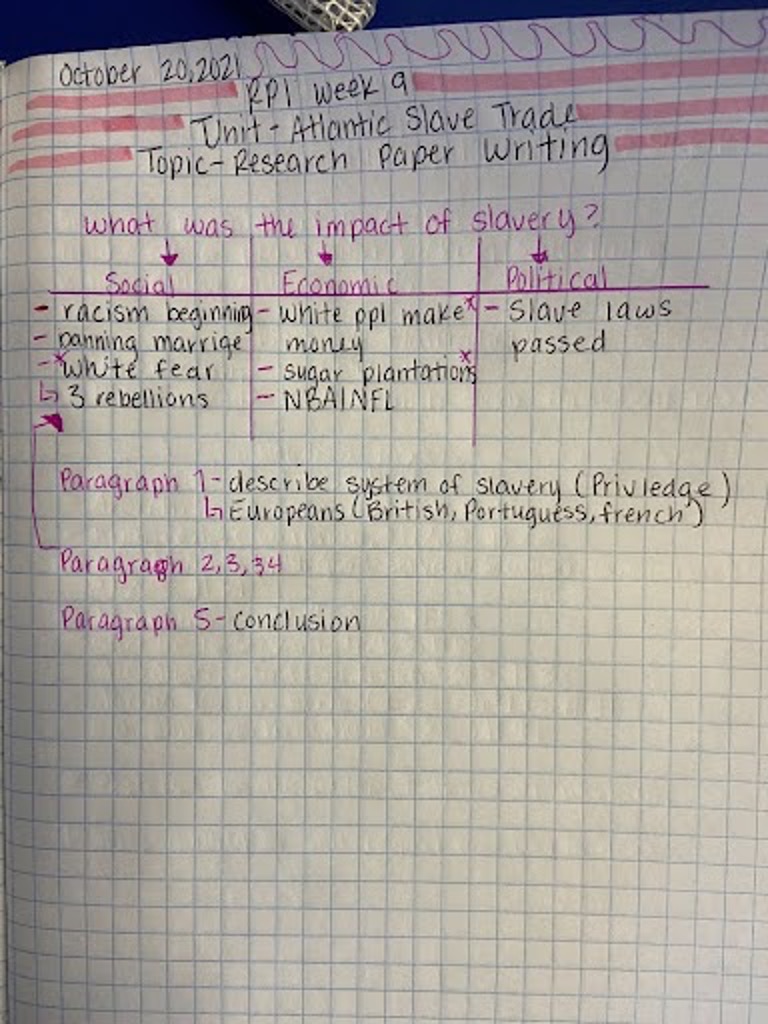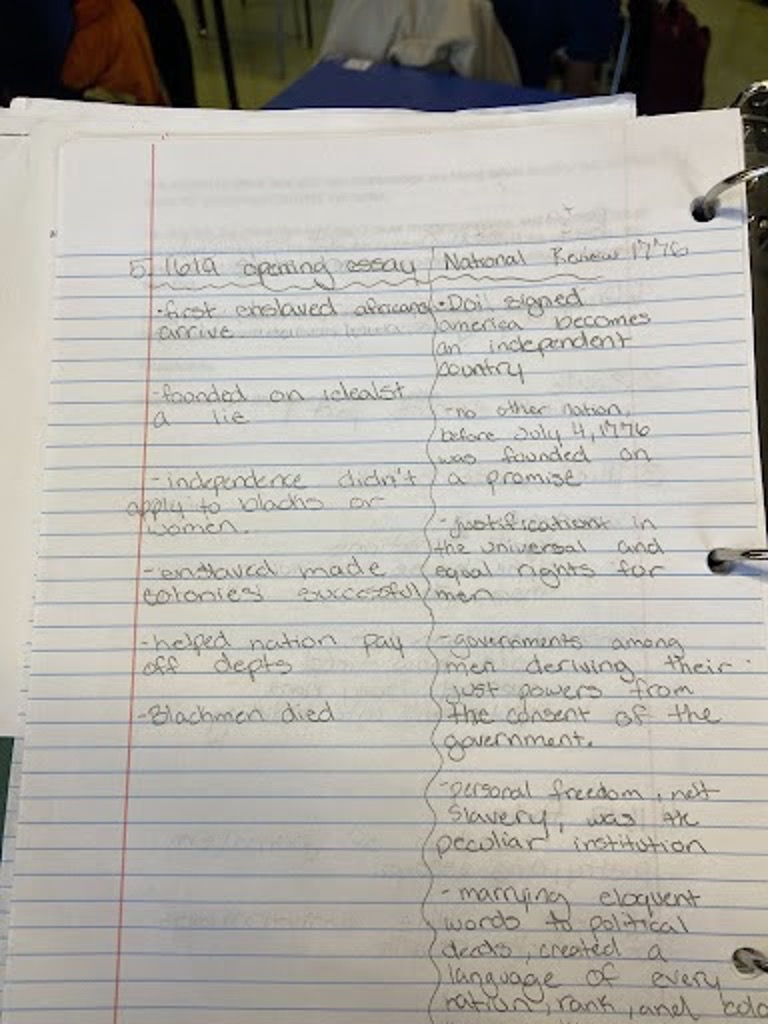Pulitzer Center Update November 11, 2021
Reshaping and Reframing African American History with The 1619 Project Books
Country:
The following reflection was written by Abigail Henry, who teaches African American history at Mastery Charter School in Philadelphia, PA. Henry shared the book The 1619 Project: A New Origin with her classes in fall 2021 as part of the Pulitzer Center-Penguin Random House 1619 Pilot Program. Henry is also part of the inaugural cohort of The 1619 Project Education Network.
I am pleased to share that The 1619 Project book has helped me reshape, rethink, and reframe how I teach African American History. I have been teaching African American History for 10 years, and I feel like it’s finally this year that I am teaching African American history appropriately in a way that meets the needs and demands of my students. In the past few weeks I have become more equipped with the knowledge and skills necessary to engage students in the important study of Black history. My students have worked hard in reading excerpts from The1619 Project essays and primary sources to accompany their understanding of the Atlantic Slave War, the contributions of Black Americans to the United States, and Black resistance. The most rewarding part of my experience teaching The 1619 Project is to witness the high level of cognitive engagement students are exhibiting as they discuss important details of labor camps, the economy of slavery, and the daily experiences of enslaved people.
One of my biggest frustrations regarding any criticism of The 1619 Project is the framing of it. Critics say any teaching of critical race theory or The 1619 Project forces white students to learn about privilege and implicit bias RATHER than celebrating how The 1619 Project provides a means for Black students to investigate the struggles and achievements of their ancestors after the arrival of enslaved Africans. My students are 99.9% Black, and through the past three weeks they have been asking some of the best history questions I have ever experienced.
In addition to the original grant award [as part of The 1619 Project Education Network], I have been using The 1619 Project book in the following ways:
- Lessons were developed for Leslie Alexander and Michele Alexander's "Fear" essay, and Nikole Hannah-Jones's "Justice" essay. These lessons were taught over multiple days and led to in-depth discussion where students made connections between the legacy of slavery and the experience of Black people today.
- In addition, my honor's class is analyzing the poetry included in the book. They read a poem for homework, and the next day worked in four-five person literacy circles to discuss the meaning of the poem, phrases and words they are trying to understand, and why the poem was selected to be in the book.

One challenge of teaching the essays is determining the best excerpt of the essays I want students to read. I teach 9th grade, and most of my students are not reading at grade level. I often have to modify the texts and guide students to specific paragraphs I want them to read. One success, however, was finding relevant primary sources to accompany the essays. For example, while discussing the relationship between Black resistance and white fear, students studied the Bacon and Stono Rebellion specifically analyzing laws that were passed after the rebellions took place. Students also analyzed letters that were sent between some of the Founding Fathers and early Governors in response to the Haitian Revolution. I teach in Philadelphia, and my students were shocked to read a letter from former Governor Mifflin to President Adams describing his concern regarding the arrival of Haitian refugees to Philadelphia. After diving deep into these specific examples of white fear, students discussed what steps politicians took to avert any future rebellion and maintain their economic, social, and political privileges. Students were then able to compare this history of white fear to George Zimmerman calling the cops on a hooded Black man in his community, and Amy Cooper feeling threatened for her life by a Black birdwatcher.
Another aspect of incorporating The 1619 Project into curriculum is that we have had frequent conversations about how slavery is taught in schools. I mentioned to students how my experience of learning about slavery in high school was literally, as Nikita Stewart argues [in the essay “Why Can’t We Teach Slavery Right in American Schools?” for The New York Times], "a dot on a timeline." For this lesson, students started by reading Marinda Branson Moore's horrifically racist "Geographical Reader." After reading this document, students read Stewart’s essay and came up with a list of reasons slavery is mistaught in schools, and discussed the need for more Black teachers. This essay made a perfect introduction to a lesson I developed on Nikole Hannah-Jones’s opening essay, “Democracy.” I wrote “1619 vs. 1776” on the whiteboard and told students they were going to debate which year is more important. For this lesson, I divided students into two groups. Half of the class read excerpts from Hannah-Jones’s essay, and the other half read excerpts from the National Review's opinion article issued this past fourth of July. Students then debated which date is more important, and their reasons why, based on key claims made in both essays. The beautiful part about this debate is the conversation that happened after. Many of the students truly felt that 1776 was more important AND they still believed 1619 should not be banned from schools.

Ultimately, I cannot express how much I have enjoyed teaching The 1619 Project. Teaching slavery is hard, and I would argue teaching slavery to majority Black students is even more challenging. I tell students all the time that given the violence they are currently experiencing in their community, the last thing I want to do is re-traumatize them. My goal is to always balance the teaching of Black history while trying to support positive racial identities. I am excited to share that The 1619 Project book has helped me to do this.
Here is an example of student writing after spending one week using the “Fear” essay from the book:
The history of the relationship between Black resistance and white fear can be traced back to the time period of slavery because every time the slaves had a rebellion, the white people took something away from their freedom. For example, in the Stono rebellion white people made it known that enslaved people can’t move around in groups of seven and they cannot leave the plantation without the slave owner's permission or without giving the slaves a ticket. Another example of white fear being displayed would be their reaction to the Haitian Revolution. For example in Document 1, a letter from Charles Pinckney to George Washington in 1791, he wrote, “I am afraid if not checked in time it is a flame which will extend to all of the neighboring states.” This shows white people’s fear because if George Washington doesn’t send help, Charles Pinckney believed the enslaved people will start taking over the states that neighbor South Carolina.
White fear of Black bodies is still present in recent years. For example, consider what happened to Trayvon Martin. He was a 17-year-old from Sanford, Florida. He got shot and killed because a white man suspected him of having a gun because he was walking with his hood on. The white man called the cops and he told the cops he thought the African American man had a gun and the cops told him to back off and not approach him. The white man with the name George Zimmerman, who was 28 and a Hispanic American, approached him anyway and then suddenly he shot and killed Trayvon Martin. Trayvon was born February 5th, 1995 and his death date was February 26th, 2012. He attended the schools Dr. Michael M. Krop senior high and Miami Carol City senior high school. This specific reason shows that the racism or fear that white people have towards black people hasn’t changed that much since the time of enslaved people.


